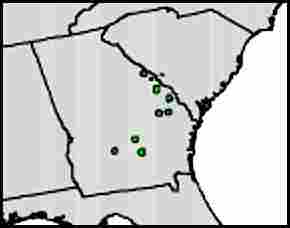Georgia Plume
(Elliottia racemosa)
Georgia Plume is a rare small tree found in Georgia, where it is officially listed as a threatened species. It gets its name from the beautiful plume-like spikes of fragrant white flowers that appear in early summer. Since these spikes are up to a foot long, a plant in full bloom can be very showy.
Each flower spike can contain several dozen individual blossoms, which open gradually from the base to the tip, and have curved petals similar to those found on some native azaleas. In fact the species is a member of the heath family, which also includes azaleas.
The blossoms develop into small round capsules containing up to 40 seeds. The attractive elliptical leaves are about 4 inches long and can turn to a vivid red or scarlet before dropping in autumn. Wild plants, which sometimes grow to 30 feet tall, are found on both moist stream banks and dry ridges.
Because it is so rare, Georgia Plume is difficult to obtain, but the plant is being cultivated. Like most members of its family, it prefers an acid well-drained soil in sun or semi-shade. It has proven to be surprisingly cold-hardy, with some specimens being successfully grown in Zone 6.
Old reports indicate that this species once grew at one location in South Carolina, but it is apparently no longer present there. There have also been population losses in Georgia, especially in areas where pine plantations have been established. But the plants at some locations are being protected, and efforts are being made to insure the preservation of the species.
Other Information
Scientific Name: Elliottia racemosa
Common Names: Georgia Plume, Southern Plume
Plant Type: Small deciduous tree
Height: up to 30 feet
Cultivation Zones: 7 - 9 (possibly also in Zone 6B)
Native Range: Scattered locations in eastern and southern Georgia. See distribution map below.
Distribution Map

Range Map Source: U.S. Forest Service. (See General Note C)
Conservation Status: NatureServe lists Elliottia racemosa as Imperiled or Vulnerable in Georgia and Possibly Extirpated in South Carolina. The state of Georgia officially classifies it as Threatened.
Cultivation: Give this plant acid well-drained soil in sun or partial shade. Wild plants often spread by root suckering, so pruning may to needed to get a tree form. Root rot is another possible problem, especially on poorly-drained soils. Go to Cultivation for more information.
Plant Sources: Georgia Plume can be difficult to find. One possible source is Woodlanders. For a link to this supplier, go to Sources of Plants.
|

